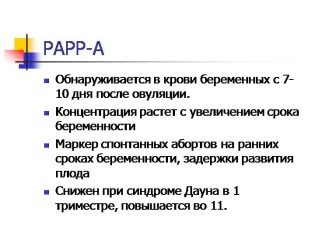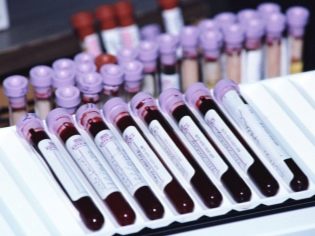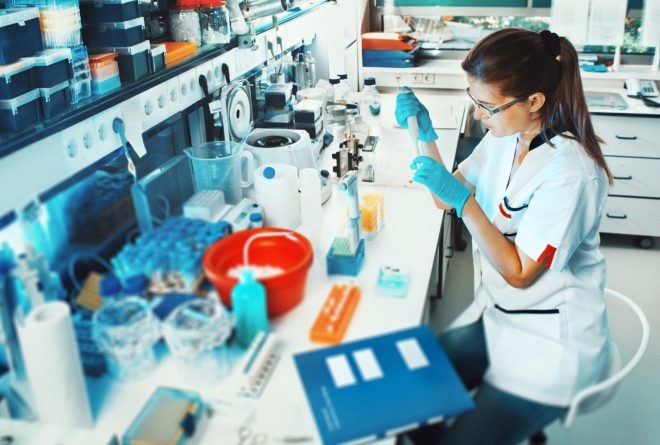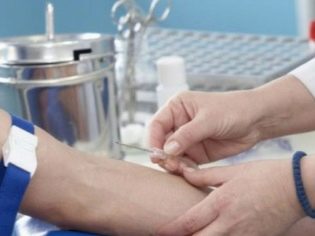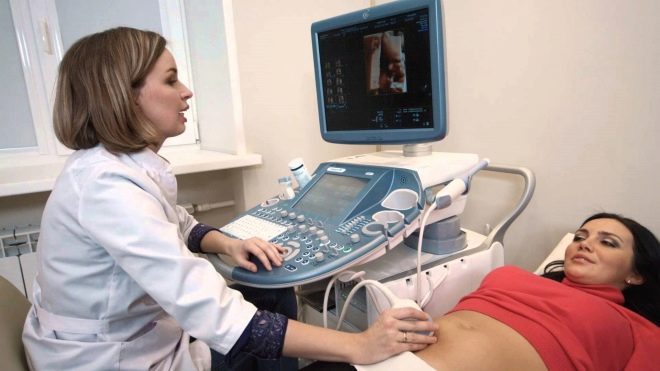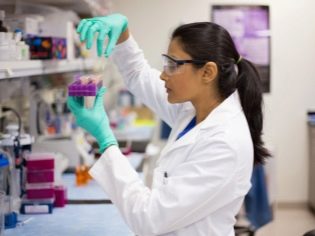What is PAPP-A, why is it determined during pregnancy, and what are the causes of deviations?
Identification of various chromosomal pathologies in the early stages of childbearing is a very important task. For this, doctors prescribe future mothers a whole range of different examinations and laboratory tests. One of them is PAPP-A.
What it is?
PAPP-A is a very important laboratory indicator, which is assigned to expectant mothers. It is included in the first prenatal screen. This spectrum of research is necessary in order to identify various genetic pathologies in the earliest stages of their formation.
This substance appears in the bloodstream of a pregnant woman during pregnancy. It is extremely specific. According to its chemical and natural structure, it is a protein of blood plasma.
The first four letters of the name of this substance are abbreviated. English-speaking specialists call it the Pregnancy-associated Plasma Protein-A. Translated into Russian, this means pregnancy-associated plasma proteins A.
Scientists believe that this substance appears in the mother’s bloodstream when a small embryo is “implanted” (implanted) into the inner wall of the uterus. This leads to the fact that portions of PAPP-A are released into the blood.
Experts believe that the definition of associated protein and the ratio of hCG are important indicators of various pathological conditions that occur in the very early period of the development of the baby. This clinical indicator is a very important examination for the detection of various CDF of the fetus.
Chromosomal pathologies are quite dangerous. For a long time, doctors could not detect them in a timely manner.
Currently, it is possible to exclude dangerous chromosomal and gene diseases in the period of prenatal development of the baby. To do this, experts lead and analyze the results of various studies and analyzes.
Execution Procedure
To determine PAPP-A, you will need to take some venous blood. To hand over such biochemical analysis is better in the morning, strictly on an empty stomach.
Only in some cases a number of exceptions are allowed, when a pregnant woman comes to the laboratory not on an “empty” stomach. As a rule, such indulgences apply only to women who suffer from diabetes, especially of the insulin-dependent type. In this case, they need to have breakfast.
On the eve of a visit to the laboratory, you should limit the consumption of fatty and fried foods. They can lead to the result of the analysis is unreliable. In this case, the doctor may ask to retake the analysis and prescribe an alternative study. Dinner in the evening before the test should be light and easy to digest.
Before submitting biochemical analyzes, especially those conducted during the first screening, Doctors strongly recommend expectant mothers to limit any physical activity.. If a pregnant woman attends a yoga class for pregnancy or is engaged in a gym, then such workouts should be limited 3-5 days before the study.
When is it determined?
This laboratory test in most cases is carried out at 12-13 weeks.In some situations, it can be held a week earlier. Timing is determined by the doctor who observes the expectant mother in the antenatal clinic.
In addition to PAPP-A, other laboratory indicators are also determined. One of them is hCG. Its concentration increases with the duration of pregnancy. In the first half of pregnancy, its content in the blood is quite high. Only in childbirth, it begins to gradually decline.
Experts identify several special groups of women who should definitely conduct screening studies. These include future mothers who became pregnant after 35 years.
Women with related cases of chromosomal and genetic diseases must also donate blood for analysis and undergo ultrasound.
Also, do not avoid the passage of this set of studies for women whose previous pregnancies ended in spontaneous miscarriages or interruptions in the early stages. Many experts also recommend to be screened and expectant mothers who have had some viral or catarrhal disease before 10-12 weeks of pregnancy.
Many future mothers mistakenly think that only an ultrasound scan during the first prenatal screening will be enough to reveal any pathology. It's not like that at all.
During an ultrasound examination at a given gestational age, only basic indicators and fetal sizes are evaluated. If the study is conducted by a not quite experienced specialist, the values of the results obtained may be incorrect. In this case, biochemical analyzes, including the determination of hCG and PAPP-A, help physicians identify dangerous pathologies already at an early stage in the development of a baby.
Chorionic gonadotropin is a very important, but very nonspecific criterion. A change in its concentration above the norm occurs in a variety of states. Not all of them are pathologies.
With multiple pregnancies, the concentration of hCG in the blood will be significantly increased.
Norms
Before evaluating the results of the analysis, the doctor will necessarily take into account all the accompanying pathologies of internal organs that a woman has. It is also very important to take into account whether the expectant mother takes any medications. If PAPP-A is lower or higher than the norm, then this requires careful attention to the woman to exclude dangerous pathologies.
In their daily practice, obstetrician-gynecologists often use a special table. It contains the values of the norm of the substance.
It is very simple and makes it quite easy to determine when PAPP-A is raised or lowered. The normal values of this clinical indicator are presented below:
Term prenatal development of the baby (in weeks) | Valid values (IU / ml) |
9-10 | 0,32-2,42 |
10-11 | 0,46-3,73 |
11-12 | 0,79-4,76 |
12-13 | 1,03-6,01 |
Causes of change
Deviations from the norm should always be a reason for the purposeful consideration of the risk of genetic and chromosomal diseases. Such violations may indicate a possible development of Down's disease.
An increase in this indicator in the blood may also be the case if the period of intrauterine development of the fetus was set incorrectly. This condition can be in severe maternal kidney disease, accompanied by the development of renal failure.
A lowered PAPP-A level at the decree period of pregnancy can be a sign of "freezing" (suspension) of pregnancy. This condition is extremely unfavorable, as it can lead to spontaneous miscarriage.
Changes in the concentration of the substance in the blood can be evidence of quite dangerous pathologies. One of them is Cornelia de Lange syndrome. This pathology is characterized by the development of a gene mutation. This disease manifests itself a disorder of psychomotor activity in a child.
It is important to note that multiple pregnancies are a special case.In this situation, the doctor can detect both babies in the uterus by the 13th week of pregnancy. In this situation, the level of PAPP-A in the blood may be somewhat different.
In order for the transcript of the test to be correct, doctors recommend donating blood for the determination of this substance. with an interval of 3-4 days after the ultrasound. In this case, it is much easier for doctors to determine the possible pathology. Reviews of many women who have already become mothers, indicate that they underwent an ultrasound scan and passed biochemical tests in just one week.
It is important to remember that by only the result of the analysis, in no case can any diagnosis be made. This will require the implementation of ultrasound, as well as other biochemical laboratory tests.
In some cases, the appointment of alternative research methods will also be required. They are appointed in cases when it is required to eliminate the risk of having a baby with chromosomal or genetic abnormalities.
Such studies can be both invasive and non-invasive. They help doctors establish the correct diagnosis, and expectant moms not to worry about the upcoming birth of the chromosomal pathology in a child.
Non-invasive prenatal DNA test
Methods of prenatal diagnosis, which are currently used, are being improved. Using them, it is possible to identify various severe chromosomal and genetic diseases in the fetus at the stage of its prenatal development.
Many expectant mothers are afraid of invasive tests. Unrest in this case is fully justified. The risk of possible complications after invasive prenatal diagnostic methods is quite high.
One of the alternative and more affordable methods, which is actively conducted by expectant mothers to eliminate the suspicion of chromosomal diseases, is the prenatal non-invasive DNA test. The technique is that doctors study the genetic material of the fetus.
By conducting such a study you can exclude the presence of a child of many genetic diseases - such as Down's disease, Edwards syndrome, Patau, Turner and many others.
Doctors who conduct this study with the help of special devices can identify microdeletion areas in the baby’s genetic apparatus. These sites are gene breakdowns that are characteristic of genetic and chromosomal pathologies.
This test can be shown to all pregnant women with suspected chromosomal diseases in the baby, regardless of their age.
Many future mommies think that this test should be done only by the "old-born." This is a big misconception. In some cases, this study is shown and women aged 20-25 years, and even during the first pregnancy.
You can pass this test in several medical centers that are engaged in such studies. The term for obtaining the results “on the hands”, as a rule, is from 12 days. It is important to note that according to American scientists, the accuracy of this analysis is 99.9%. It is possible to conduct such a study from the 9th week of pregnancy.
The advantages of this test are numerous. This test is easy to perform. It is not invasive. This means that mother’s belly, where the baby is, is not punctured. In order to conduct a laboratory study, it is only necessary little venous blood. Medical centers that are engaged in this type of research can send the results to e-mail. Less research is high cost.
For information on what PAPP-A is, as well as decoding other lab indicators, see the following video.

